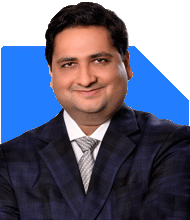Can I build wealth of 6 crores in 5 years with 31 lacs in MF and 1.3 cr in FD?
Ramalingam Kalirajan |10924 Answers |Ask -Follow
Mutual Funds, Financial Planning Expert - Answered on Aug 30, 2024
He has an MBA in finance from the University of Madras and is a certified financial planner.
He is the director and chief financial planner at Holistic Investment, a Chennai-based firm that offers financial planning and wealth management advice.... more

i have 31 lacs in the MF generated over 7 years by now. i have fixed deposit of 1.3 crore. yearly contribution to MF currently is around 5 lacs(there are 7 to 8 MFs). is it possible to create a wealth of 6 crores in next 5 years?
Assessing Your Current Financial Position
Current Mutual Fund (MF) Value: You have Rs. 31 lakh invested in MFs. This has grown over 7 years. It's a good start, showing a commitment to long-term growth.
Fixed Deposits (FDs): You have Rs. 1.3 crore in FDs. This ensures safety and liquidity but with limited growth potential.
Annual MF Contribution: You contribute Rs. 5 lakh yearly to your MFs. This is a disciplined approach, and it's crucial to continue this.
Goal: You want to reach Rs. 6 crore in 5 years. This is a clear, ambitious target.
Evaluating Growth Potential
Mutual Funds' Expected Growth: Typically, equity mutual funds have the potential to grow at 10% to 12% annually. However, market conditions play a significant role in this.
Fixed Deposit Returns: FDs offer returns of around 5% to 7% annually. While safe, these returns are not enough to achieve high growth.
Gap Analysis: With your current portfolio, it's essential to assess if reaching Rs. 6 crore in 5 years is realistic. We’ll explore this with a structured approach.
Strategy for Wealth Creation
1. Maximize Equity Exposure
Higher Growth Potential: To aim for Rs. 6 crore, you need higher returns. Equity mutual funds provide this potential but come with higher risks.
Diversify Across Equity Funds: Diversifying into large-cap, mid-cap, and small-cap funds can help balance risk and reward. Each category has a different risk-return profile.
Increase SIP Contributions: If possible, consider increasing your annual contribution to MFs. Higher investment in equity funds can accelerate growth.
Risk Assessment: While higher equity exposure is necessary, it's crucial to understand the associated risks. Equity markets can be volatile, especially in the short term.
2. Reassess Fixed Deposit Allocation
Safety vs. Growth: FDs are safe but offer lower returns. If you rely heavily on FDs, achieving Rs. 6 crore may be difficult.
Partial Reallocation to Debt Funds: Consider reallocating a portion of your FDs into debt mutual funds. These funds offer slightly higher returns than FDs while maintaining relative safety.
Staggered FD Maturity: If you prefer keeping FDs, consider laddering them. This means having FDs maturing at different intervals, ensuring liquidity and reinvestment at possibly better rates.
3. Leverage Hybrid Funds
Balance Risk and Reward: Hybrid funds invest in both equity and debt. They offer a balanced approach, suitable for those not comfortable with full equity exposure.
Stability with Growth: These funds provide stability through debt investments and growth through equity exposure. They can be an essential part of your portfolio.
4. Tax Efficiency
Tax Planning: Ensure your investment strategy is tax-efficient. Long-term capital gains from equity mutual funds are taxed at a lower rate. This can improve net returns.
5. Avoid Direct Equity Investment
Focus on Mutual Funds: Given the complexity and risks of direct equity investment, it’s advisable to stick with mutual funds. They offer professional management and diversification.
Active Fund Management: Actively managed funds, guided by a Certified Financial Planner, can outperform the market. Avoid index funds, as they only track the market without aiming for outperformance.
Implementation and Monitoring
1. Regular Portfolio Review
Annual Reviews: Conduct an annual review of your portfolio with a Certified Financial Planner. This helps adjust your strategy based on market conditions and personal circumstances.
Rebalancing: Rebalance your portfolio if necessary. If equity markets perform exceptionally well, your portfolio might become equity-heavy. Rebalancing ensures you maintain your desired risk level.
Performance Tracking: Regularly track the performance of your investments. Ensure they align with your goal of achieving Rs. 6 crore in 5 years.
2. Adjusting Strategy Based on Market Conditions
Stay Flexible: Be prepared to adjust your strategy if market conditions change. For instance, if equity markets are bearish, you might need to increase your contributions to stay on track.
Avoid Panic Selling: Market volatility can be challenging, but avoid panic selling during market downturns. Stay committed to your long-term plan.
3. Emergency Fund and Liquidity Management
Maintain an Emergency Fund: Ensure you have an adequate emergency fund. This should be kept separate from your investment portfolio and can be held in liquid funds or a savings account.
Liquidity for Short-Term Needs: Ensure some of your investments are liquid or can be liquidated without penalties. This ensures you’re not forced to sell long-term investments prematurely.
Final Insights
Realistic Expectations: Achieving Rs. 6 crore in 5 years is ambitious. While it's possible with disciplined investing and a well-structured portfolio, it requires understanding the associated risks.
Balanced Portfolio: Aim for a balanced portfolio with a mix of equity, debt, and hybrid funds. This provides growth potential while managing risk.
Seek Professional Guidance: Working closely with a Certified Financial Planner is crucial. They provide the expertise needed to navigate market complexities and ensure your strategy aligns with your goals.
Long-Term Commitment: Stay committed to your plan, review it regularly, and be prepared to make adjustments as needed. This disciplined approach is key to achieving your financial goals.
Best Regards,
K. Ramalingam, MBA, CFP
Chief Financial Planner
www.holisticinvestment.in
You may like to see similar questions and answers below
Hardik Parikh | Answer |Ask -Follow
Tax, Mutual Fund Expert - Answered on Apr 19, 2023
Vivek Lala |323 Answers |Ask -Follow
Tax, MF Expert - Answered on Mar 09, 2024
Radheshyam Zanwar |6754 Answers |Ask -Follow
MHT-CET, IIT-JEE, NEET-UG Expert - Answered on Dec 23, 2025
Purshotam Lal |70 Answers |Ask -Follow
Financial Planner, MF and Insurance Expert - Answered on Dec 23, 2025
Purshotam Lal |70 Answers |Ask -Follow
Financial Planner, MF and Insurance Expert - Answered on Dec 23, 2025
Samraat Jadhav |2522 Answers |Ask -Follow
Stock Market Expert - Answered on Dec 23, 2025
Samraat Jadhav |2522 Answers |Ask -Follow
Stock Market Expert - Answered on Dec 23, 2025
Samraat Jadhav |2522 Answers |Ask -Follow
Stock Market Expert - Answered on Dec 23, 2025
Samraat Jadhav |2522 Answers |Ask -Follow
Stock Market Expert - Answered on Dec 23, 2025
Samraat Jadhav |2522 Answers |Ask -Follow
Stock Market Expert - Answered on Dec 23, 2025
Dr Nagarajan J S K |2578 Answers |Ask -Follow
NEET, Medical, Pharmacy Careers - Answered on Dec 23, 2025
Samraat Jadhav |2522 Answers |Ask -Follow
Stock Market Expert - Answered on Dec 23, 2025

























